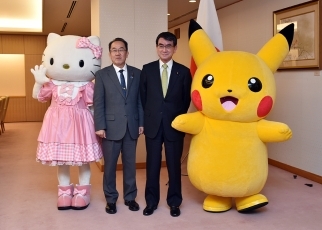
Japan is built on a culture of collectivism and, as such, fosters a sense of unity and teamwork that extends to the field of marketing through the promotion of "kawaii" characters and mascots. There are several reasons why targeting audiences with cuteness can be an effective selling point.
Research (Birlea, 2021) shows that adorable mascots promote team spirit and constructive competition which contributes to trust and group harmony within society. Additionally, Japanese societal norms, such as the distinction between true feelings and intentions (“honne”) and publicly accepted opinions (“tatemae”), find release in the emotionally charged advertisement which makes “audience[s] feel liberated from everyday stress, even for a brief moment” (p. 75). However, as stress becomes inescapable these days, and societal stress mounts, individuals seem to gravitate more towards characters with subtle, unassuming expressions, such as Hello Kitty and Tarepanda (LBB Editorial, 2022).
Aside from societal liberation, cute mascots also play an important role in fostering an emotional attachment among consumers. One of the ways this is made possible is through the concept of ‘animism’, which is an ancient Japanese belief that suggests divinity resides in all things (“Animism,” 2024). As consumers interact with products or services represented by these endearing mascots, they tend to associate positive experiences with the brand which, in turn, lead to long-term brand loyalty.

Social media has also played a role in the “kawaii” marketing strategies. Platforms like Instagram and TikTok serve to share large quantities of ‘cute’ content, leading to enhanced brand visibility (LBB Editorial, 2022). Furthermore, the sharing of "kawaii" content creates a sense of community among enthusiasts, creating a virtual space where they can engage and connect over their shared affection for adorable characters.
Animism. (2024). In Wikipedia. Wikimedia Foundation. https://en.wikipedia.org/w/index.php?title=Animism&oldid=1215554415
Birlea, O.-M. (2021). How are Kawaii (Cute) Fictional Characters Used in Japanese Advertising. Journal of Media Research, 14(1 (39)), 55–78. https://doi.org/10.24193/jmr.39.4
LBB Editorial. (2022, April 13). Kawaii Culture in Japanese Advertising: Why Do We Love It? Lbbonline.com; Little Black Book. https://lbbonline.com/news/kawaii-culture-in-japanese-advertising-why-do-we-love-it
MOFA Japan. (2017). Pokémon and Hello Kitty appointed as Special Envoys (Mascot Character) for EXPO 2025 OSAKA, KANSAI, JAPAN [Online image]. In Ministry of Foreign Affairs of Japan. https://www.mofa.go.jp/press/release/press4e_001814.html